Lecture 8: Neoclassicism and Nationalism in the Early American Republic
1/15
There's no tags or description
Looks like no tags are added yet.
Name | Mastery | Learn | Test | Matching | Spaced |
|---|
No study sessions yet.
16 Terms
Historical context
American Neoclassicism
Flourished in the 18th & 19th centuries
The US was seeking to define its identity as a new nation
Uses (2) & Tensions (1) of American Neoclassicism
Uses
Allowed the US government to claim a Western ideological lineage
Referenced Greek democracy & the Roman Republic
Ideal values: democracy & justice
Provided cover for American cultural contradictions
Neoclassicism embodied the moral disparity between US founding principles as a land of liberty & equality, and the persistent disenfranchisement of women & POC
Tensions
Symbols of Neoclassicism were BOTH:
(1) Useful for establishing a visual vocabulary for the US
(2) An uneasy fit w/ a modern nation
Disjuncture w/ reality was sometimes comical
Early public portrayals of George Washington
Historical context
The 1st American president
A farmer & soldier
A reluctant political leader
NO country had had a democratically-elected president before
Artists struggled to:
(A) Give a portrait figure the gravitas of high office
(B) WITHOUT necessarily deferring to royal trappings & indications of high birth
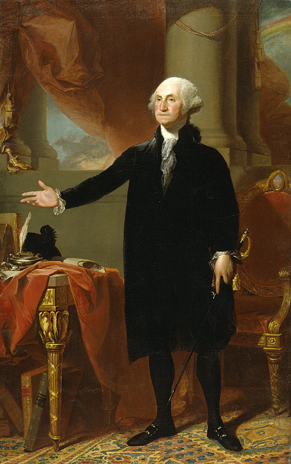
Early public portrayals of George Washington
Named example 1
George Washington (Lansdowne Portrait) (1796), Gilbert Stuart
Provenance
Essentially became the official portrait of Washington used by the US
Description
Washington standing in a portico-like structure
2 pairs of Doric columns
A red curtain pulled aside to reveal a background of open sky
Rainbow symbolises the end of the revolutionary conflict
Pose: arm raised
Classically-inspired oratorical pose
Clothing:
An American-made black velvet suit
NOT Roman attire
Grasps a ceremonial (NOT battle) sword
Surrounding objects:
Symbols of the newly-formed United States
Top of chair adorned w/ a seal depicting the US flag
Table leg beneath his arm is inspired by the ceremonial mace used in the US House of Representatives
BUT topped w/ eagles: American symbol
Ceremonial mace itself is inspired by a Roman fasces (symbol of civil authority)
Books under the table:
Federalist papers
Constitutional by-laws
= Washington’s leadership is based via rule of law, NOT birthright/military strength
Complex web of symbols: elements symbolic to the new American nation + icons of the Roman Republic
Interpretation
Stresses Washington’s position as a civilian commander-in-chief
NOT as a warrior, king, or God
But as a leader of state commanding a democratic form of government; a moral man
Contrasts w/ imposing grandeur of royal portraits
Washington’s pose of power is based on classical statuary, plain dress & a noble demeanour
Clarity & simplicity of the neoclassical style expressed the practical ideals of democracy

Early public portrayals of George Washington
Named example 2
George Washington (1788-92), Jean-Antoine Houdon
Provenance
French artist
Marble sculpture
Made for the rotunda of the Richmond State Capitol in Virginia
Description
Clothing:
Contemporary 18th-century attire
Pose:
Contrapposto
Washington rests his arm on a bundle of rods
Roman fasces (symbol of civil authority)
BUT 13 rods
= symbolises the original 13 colonies & the US motto at the time (‘e pluribus unum’ = ‘one of many’)
Behind Washington: a farmer’s ploughshare
Association regularly made between Washington & Cincinnatus
Ancient Roman Republican hero
Having won a war as a Roman dictator, stepped down from power & returned to his farm
Similar to Washington’s path from military leader → presidency → his Virginia plantation
Interpretation
References the Roman Republic to establish a moral authority for American civil society
Allusions to grandeur & morality
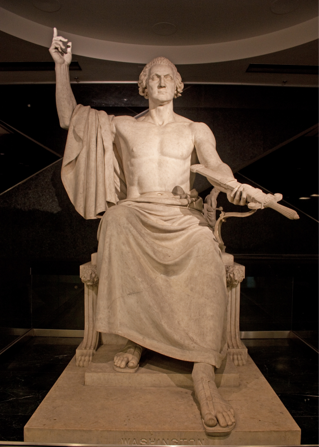
Early public portrayals of George Washington
Named example 3
George Washington (1840), Horatio Greenough
Provenance
Marble sculpture
Was initially intended for the rotunda of the Capitol building
BUT was immediately criticised & sidelined as a work of art
(1) Pagan connotations
(2) General inappropriateness of having a buff, shirtless Washington presiding over people
Not befitting the dignity of the presidency as an office
Inconsistent w/ other types of representation of Washington
Thought of as comical
Description
Clothing:
Bare-chested
In Roman-style drapery
Pose:
Seated on a throne
Allusion to Phidias’s Zeus Olympios
Gestures w/ 1 hand towards the heavens
As the original source of all power
w/ his other hand: offers a sheathed sword to the people
Interpretation
All power comes from above and then must be offered to the people
Poor reception: different usages of Neoclassicism = different results
Represented in terms of classical myth
Aligns presidential power w/ that of the Gods
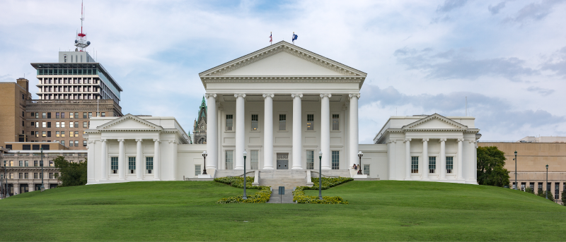
American Neoclassical Architecture
Named example 1
Virginia State Capitol (1795), Thomas Jefferson & Charles-Louis Clérrisseau
Provenance
Thomas Jefferson
The 3rd president of the US
Author of the Declaration of Independence
One of the most accomplished architects in American history
An early proponent of Neoclassical architecture in the US
Believed that art was a powerful tool for eliciting social change & bringing about a general sense of enlightenment
BUT was also an enslaver of people
Ignored many moral contradictions of the US’s founding
Never forgave the British for the offences of the American Revolution
Often looks to examples of Roman architecture in France
= make a national distinction
Virginia State Capitol
1st major project accomplished after the signing of the Declaration of Independence
Was the 1st to introduce Neoclassical vocabulary into American architecture
Description
Modified version of the Maison Carrée
Roman temple in Nîmes, France
Jefferson visited on a trip to France
Interpretation
Jefferson hoped to reinforce ideas about a classical past, BUT these contradicted w/ lived realities of his present
Intentions for the building:
To symbolise the power of the people to govern
To serve as a model for civic architecture & the organisation of the federal government
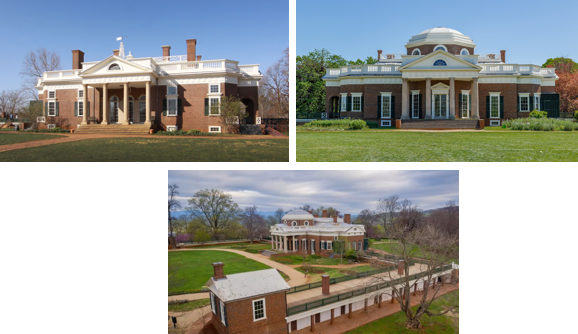
Jefferson’s own home in Monticello (1772-1809), Thomas Jefferson
Provenance
Jefferson designed his own home
Was a working plantation: 130 slaves lived & worked on the property
Looked NOT to local architecture that was in vogue
BUT to classically-inspired examples
Description
Plantation house
Location:
NOT placed along the banks of a river (as was customary at the time)
But on a hill (Monticello = Italian for ‘little mountain’)
East portico
Palladian pavilion
Emphasis on symmetry, proportion, and classical elements
West façade
Based on the Hotel de Salm in Paris
Symmetrical, single-story brick home
Doric entablature on the front
2-column deep extended portico
Triangular pediment
Decorated by a semicircular window
= creates a powerful sense of horizontality, rationality, & classical order
South wing
Next to the west façade
Housed the kitchen buildings & quarters for enslaved people at Monticello
Interpretation
Fundamentally shows contradictions in how Neoclassicism is deployed in the US
Location of site on a hill:
Allowed Jefferson to assume an ideological, elevated position
Designed lofty vantage points where he could overlook the enslaved people on his property
Intentionally diminished the visibility of slavery on his property (were housed below the hill)
The fact of slavery diminishes his high moral standing

Capitol Building in Washington, DC
Provenance
Architecture known as Federal style: American Neoclassicism
Designs solicited through a competition (1792)
Function:
To provide quarters for the Senate & House of Representatives (2 branches of government other than the Presidency)
Description
Name:
Deliberately invokes the famous temple of Jupiter Optimus Maximus on Capitoline Hill in ancient Rome
Development over time:
(1) Original design by William Thornton (1793)
An orthodox, high-style Georgian building
w/ a dome & portico
Reminiscent of the Pantheon BUT an expansion of it
(2) Domed rotunda was added to the building (1860s)
Meant to be a focal point
Interior:
Designed by Benjamin Latrobe
Drew upon classical style BUT made it distinctly American
E.g. altered the types of organic decoration incorporated into classical columns
Rather than using acanthus leaves
Used plants indigenous to/significant to the economy of the Americas (e.g. corncobs, tobacco leaf & flower)
Interpretation
The classical aesthetic vocabulary lends a sense of grandeur; projection of power & nobility
The construction of US national identity appropriates from indigenous culture

Progress of Civilisation (1853-55), Thomas Crawford
Provenance
The sculptural frieze just above the entrance of the Senate wing on the US Capitol building
Description
An allegorical personification of America @ the centre
Scenes on either side illustrate what was perceived by the artist (& other white Americans) to represent the advance of civilisation
On the right: white woodsman chopping down trees to make way for agriculture
On the left: children & adult men representing different aspects of American society
A soldier
A merchant
A teacher & schoolchildren
In the rightmost corner: a seated Native American man
Holds his head in his hands
Mourning the destruction of the landscape happening before his eyes & the advance of white settlers
Interpretation
The construction of US national identity both appropriates from & diminishes indigenous culture
Untroubled representation of the displacement of indigenous people
Embodies a 19th-century belief in the inevitable triumph of white American civilisation over indigenous cultures in the progress of civilisation
Inherent contradiction: federal architecture was constructed w/ enslaved labour
High ideals expressed through visual language of Neoclassicism represent a thin veneer of stylistic ideology placed over more fundamental moral failings
Hiram Powers (3)
Was a leading practitioner of the Neoclassical style in the mid-19th century (1850s)
His vision relied on a limited formula:
(1) Nude figures, idealised & broadly classical in inspiration
(2) Limited attributes that tie them into a recognisable allegory
Historical context:
19th-century American audiences were prudish & sensitive
Any representation of nudity was considered controversial
Powers used symbols in a way that would justify the nudity by tying it into a narrative
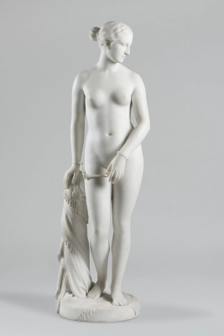
The Greek Slave (1842), Hiram Powers
Provenance
Powers wrote an explanatory text accompanying the exhibition of the work
Provided historical context for the piece
Offered a sentimental reading of the young woman’s plight
‘Her father and mother, and perhaps all her kindred, have been destroyed by her foes, and [...] tempered indeed by the support of her reliance upon the goodness of God. Gather all these afflictions together, and add to them the fortitude and resignation of a Christian, and no room will be left for shame.’
Inspired by the Greek War of Independence (1821-1832) against the Ottoman Empire
A successful rebellion by Greek revolutionaries
Description
Depicts a Greek woman exposed for sale at a Turkish bazaar
Chains around her hands & manacles
Locket & cross carved on the support beam
White Greek woman
May seem illogical/irresponsible in the midst of the political turmoil of American slavery
BUT was widely interpreted by audiences as a representation of the plight of enslaved black people in the US
Interpretation
Representational ambiguity
Fusion of Neoclassical whiteness w/ visual tropes drawn from the contemporary abolition movement & Orientalising imagery
The classical figure as a container for different visual associations
Encouraged viewers to see the subject’s humanity > focusing on race & prejudice
WHILE still reconsidering the issue of slavery
= allowed it to cleverly speak to the topic of American slavery indirectly, while still being a popular sculpture accepted by multiple & complex publics
Its representational ambiguity has been criticised
E.g. the work’s staging at the Great Exhibition in London’s Crystal Palace (1851)
Post-abolition in England but NOT the US
Viewers were more quick to make an explicit connection between the work & rising anti-slavery sentiment in the US
Criticised the fact that this was not happening more overtly w/ American audiences
Slavery as a live issue repressed under the veneer of Neoclassicism & Powers’s sculpture
BUT the sculpture was nonetheless a successful symbol of the abolitionist movement in the US
Powers’s goal in providing the explanatory text:
Emphasis on the subject’s innocence & Christian values
To convince American audiences who were scandalised by representations of nudity
That viewing the sculpture was a high-minded, aesthetic act
Enabled contradiction to work: clothed in Christian virtue DESPITE being represented in the nude
Powers had abolitionist leanings
Made this figure of an enslaved woman → a sympathetic figure
At a time when slavery remained legal in the US
Harriet Hosmer
Professional female sculptor
‘Every woman should have the opportunity of cultivating her talents to the fullest extent, for they were not given to her for nothing’
Distinctive look:
Part of the dress reform movement at the time
Shorter bloomer skirt = could work more easily
Beret signifying artistic identity
Reception
Many American visitors appreciated her growing talent
BUT some were shocked at what they considered to be her unfeminine appearance, manners, & flamboyant behaviour
Physical labour involved in making large-scale marble sculptures was considered unfeminine
Interests:
Representing the historic plight of women
In a way that took subjects that were traditional to Neoclassical architecture, and altering them slightly to represent something different
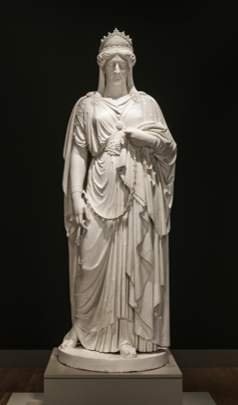
Zenobia in Chains (1859). Harriet Hosmer
Provenance
Marble sculpture
Responds to Hiram Powers’s The Greek Slave directly
Description
Depicts the Queen of Palmyra
Conquered Egypt
Reigned until Roman forces overthrew her
In this moment, she’s marched through the streets by Roman emperor Aurelian following her capture
Dignified
Her head held high despite being in chains
NOT nude/an allegory
Hosmer tried to make her:
‘Too proud to exhibit passion/emotion of any kind’
‘She’s a prisoner, but calm, strong, and grand to herself’
Interpretation
A show of skill
Intricate details of her dress & folded drapery are a testament to Hosmer’s abilities
A counterpoint to the typical depiction of women as allegories & nudes rather than heroic figures
An early example of feminist art
The focus here is NOT Zenobia’s victimhood, BUT the dignity of her profile
Her bearing stresses strength > victimisation
Edmonia Lewis
Background
Black, Haitian & Indigenous American heritage
Shattered expectations by becoming a successful sculptor at a time when the art world was dominated by white men
BUT faced significant racial & gender discrimination throughout her career
Interests:
Explored racial & gender empowerment
BUT sometimes represented racial difference in ambivalent ways
E.g. Forever Free (1875): woman represented w/ white, Europeanised features rather than as a recognisably black woman
= NOT an example of strong black womanhood
This may represent her attempt to escape the limited autobiographical interpretation that was often placed upon her
The reason why she left the US in the first place
Always perceived as an artist of colour, and not just an artist
Did not want to similarly racialise her subjects
YET doesn’t avoid topics of slavery & identity completely
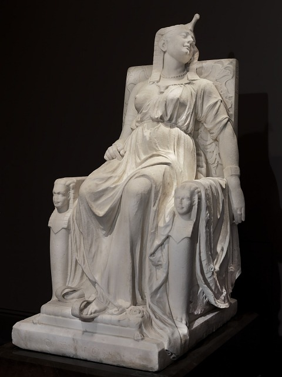
The Death of Cleopatra (1876), Edmonia Lewis
Provenance
When exhibited, it was:
(A) Praised for its realism
(B) Critiqued for being ghastly & repellent
Description
Depicts Cleopatra as she is dying
Wearing Roman attire (toga)
In majestic repose on her throne
After she’s allowed herself to be bitten by a snake
Expression of near ecstasy on her face
Interpretation
Cleopatra as a symbol of Africa
An African Queen taking agency over her fate
Unusual moment of depiction: most contemporary artists represent idealised Cleopatra contemplating suicide
Only as a victim & an imprisoned figure
Wrestling with/bemoaning her fate
In Lewis’s work, Cleopatra is taking charge
Expresses joy at being released from earthly problems
A sense of freedom that was unconventional but real for an embattled artist who persevered in making a career in face of overwhelming prejudice